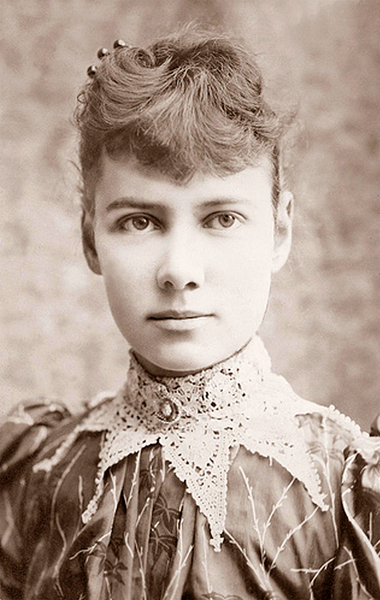Investigative Classics: Inside the Madhouse, by Nellie Bly, 1887
Investigative Classics is a weekly feature on noteworthy past examples of the reporting craft.

“On the 22d of September I was asked by The World if I could have myself committed to one of the Asylums for the Insane in New York, with a view to writing a plain and unvarnished narrative of the treatment of the patients therein and the methods of management, etc. “
So wrote Nellie Bly (né Elizabeth Jane Cochran) in the New York World in 1887, beginning one of the most famous early pieces of undercover reporting. Bly – who is also remembered for articles on the lives of working women and her Phineas Fogg-inspired trip around the world in 72 days – reported this first-person exposé in two parts. It leaves no doubt why mentally ill people were often called inmates instead of patients.
The first installment (illustration detail, above) chronicles her efforts to convince the authorities she should be sent to the asylum at Blackwell’s Island. The doctor at Bellevue apparently did not need much persuasion. She writes:
My nose was very cold, so I covered up my head and was in a half doze, when the shawl was suddenly jerked from my face and a strange man and Miss Scott stood before me. The man proved to be a doctor, and his first greetings were, “I’ve seen that face before.” “Then you know me?” I asked, with a great show of eagerness that I did not feel. “I think I do. Where did you come from?” “From home.” “Where is home?” “Don’t you know? Cuba.” He then sat down beside me, felt my pulse, and examined my tongue, and at last said: “Tell Miss Scott all about yourself.” “No, I will not. I will not talk with women.” “What do you do in New York?” “Nothing.” “Can you work?” “No, señor.” “Tell me, are you a woman of the town?” “I do not understand you,” I replied, heartily disgusted with him.
“I mean have you allowed the men to provide for you and keep you?”
I felt like slapping him in the face, but I had to maintain my composure, so I simply said: “I do not know what you are talking about. I always lived at home.”
After many more questions, fully as useless and senseless, he left me and began to talk with the nurse. “Positively demented,” he said. “I consider it a hopeless case. She needs to be put where someone will take care of her.”
The second installment describes the grim conditions at Blackwell’s Island – a Dickensian world of cold baths, rotten food and harsh treatment. One of the most memorable scenes depicts the “women on the rope.”
We had not gone many paces when I saw, proceeding from every walk, long lines of women guarded by nurses. How many there were! Every way I looked I could see them in the queer dresses, comical straw hats and shawls, marching slowly around. I eagerly watched the passing lines and a thrill of horror crept over me at the sight. Vacant eyes and meaningless faces, and their tongues uttered meaningless nonsense. One crowd passed and I noted by nose as well as eyes, that they were fearfully dirty. “Who are they?” I asked of a patient near me. “They are considered the most violent on the island,” she replied. “They are from the Lodge, the first building with the high steps.” Some were yelling, some were cursing, others were singing or praying or preaching, as the fancy struck them, and they made up the most miserable collection of humanity I had ever seen. As the din of their passing faded in the distance there came another sight I can never forget:
A long cable rope fastened to wide leather belts, and these belts locked around the waists of fifty-two women. At the end of the rope was a heavy iron cart, and in it two women–one nursing a sore foot, another screaming at some nurse, saying: “You beat me and I shall not forget it. You want to kill me,” and then she would sob and cry.
Conditions for the less violent inmates were just as cruel, leading Bly to ask:
What, excepting torture, would produce insanity quicker than this treatment? Here is a class of women sent to be cured? I would like the expert physicians who are condemning me for my action, which has proven their ability, to take a perfectly sane and healthy woman, shut her up and make her sit from 6 A.M. until 8 P.M. on straight-back benches, do not allow her to talk or move during these hours, give her no reading and let her know nothing of the world or its doings, give her bad food and harsh treatment, and see how long it will take to make her insane. Two months would make her a mental and physical wreck.





